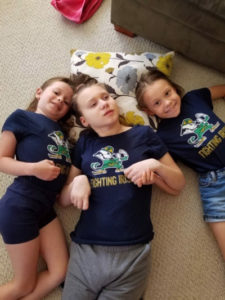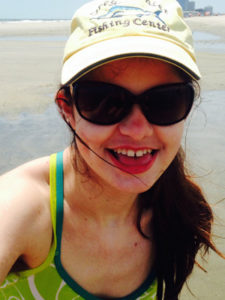'Almy' is a non-profit association that aims to:
Raise awareness of the existence of rare diseases with no medical solutions.
Mobilize human and financial resources to support research and development of a model that will contribute to the quality and life expectancy of patients, believing that even in situations that seem terminal, changing the perspective can change the picture.
The association was founded on the initiative of Adi Goldenberg, mother of Elya who suffers from a rare neurodegenerative childhood disease. After many years of searching, the cause of the disease was found – a rare mutation in the UBTF gene. The discovery provided a lead and a glimmer of hope, but the medical community is still helpless in its encounter with rare diseases, and research and treatment suffer from under-funding and little interest compared to common diseases.
But for parents like Adi, giving up is not an option. For this purpose, 'Almy' was established. The association promotes Interdisciplinary collaboration, scientific-medical-technological, with the idea that a unique disease requires a unique model of discourse in order to promote the discovery of a cure. We believe that the answers are already there, waiting for us to find them, and that just as a disaster can happen at any given moment, so can a miracle!
Fortunately, the experts too agree that something can be done! The best minds and hearts from universities and laboratories in Israel and around the world rallied to help Elya and her friends, led by the Weizmann Institute in Israel and the Jackson Laboratories in the USA.
We at 'Almy' work day and night to promote research through creating connections between doctors, scientists and technological innovation, but our children’s clock is ticking.
Now that something can be done about it, our real challenge is to raise the necessary financial resources to find Elya's, and other children in her condition, the “golden heart flower” as soon as possible.
Photo Roy Dahan
Vision
At ALMY we believe that a unique disease requires the development of a unique model of discourse in order to promote the discovery of a cure. Our premise is that the solutions for our children's recovery can be found at the interfaces between different disciplines of knowledge. Our task is to create the right connections in order to find them. To this end, we promote scientific-medical-technological cooperation. We aim to repurpose existing medicines and medical technologies and to connect the scientist with the doctor, i.e. the scientific findings and the symptoms of the disease.
During the journey I made with my daughter, from the first symptoms to the diagnosis many years later, I encountered the buffer that exists between different bodies of knowledge, science and medicine; the relative slowness of science in finding cures and therapies; the gap between the technological achievements in fields such as gaming, the military and outer space compared to its application in medicine. ALMY was founded to bring all these elements into synergic function.
We believe in an interdisciplinary, creative ’round table' – of researchers and professionals from fields such as genetics, neurology, metabolism and biology, alongside less obvious disciplines such as behavioral sciences, zoology, cancer research, geriatrics, music and even electronics and computer science – can promote innovation much needed for both rare and common pathologies (such as Parkinson's and Alzheimer's).
Discoveries concerning specific syndromes can contribute to the general understanding of pathologies and symptoms. Many of these are not specific to degenerative disease such as insomnia, weight problems, etc. The model of interdisciplinary dialogue can be a breakthrough in terms of diagnosis, treatment and channelling of resources. These forum could also examine treatment options that are not specific to the genetic syndrome but can affect the course of the disease, the symptoms and the quality of life.
Photo Tiki Ozer
Research
We are fortunate and grateful to be supported by great minds and hearts, excelling not only scientifically but also in their human practices, motivated not only by intellectual curiosity or the will to excel, but by the passion to contribute to the well-being of others, sharing their valuable time, budgets and knowledge.
The search for a cure by the “UBTF Collaborative” is not seen only as a monolithic goal to be achieve, i.e. complete eradication of the disease, but also as searching to improve the patient’s quality of life and supporting it as much as possible.
As of today, there are 2 teams researching the disease:
UBTF Collaborative
An interdisciplinary international team of researchers and doctors supported by The Jackson Laboratory, Weizmann Institute Of Science, Minovia, Vivox and Yaldut Hadasha
Further reading
For further information please contact [email protected]
Cure UBTF
Supported by Massachusetts General Hospital & n-Lorem foundation
Further reading
For further information please contact [email protected]
Our Story
When Elya was born everything looked good, "normal", they call it. A sweet, pleasant baby – a wonder. I remember she talked long before she walked.
At about age 3.5, some of her movements seemed a bit awkward, but alongside that she memorized entire texts of books, had a good sense of humor and positive to her environment. It was fun to go to stores with her knowing she would not touch, not knock down or break things. She enjoyed meeting with other kids, give up easily a toy and was not pushy. It was fun to sit with her in a cafe and I was already fantasizing how, when she grew up, we would walk and laugh and talk about matters of importance and feel on the top of the world.
When Elya was about 4 years old, her speech became gradually less and less clear and then the tests began: neurological, metabolic, genetic. First MRI in relatively older age showed mild changes in the brain, but nothing came under any heading.
The most accurate diagnosis for those days was given at the age of five: "the girl understands the essence of things, but does not know how to organize the information, and there is a big difference between her input and output.
At this point I realized I could not leave Elya alone. She needed mediation and guarding, because I was not sure she could tell me what she feels or what is happening to her, or that I would understand what she means, what she is saying.
At age 10, while she still could walk, still could thread tiny beads on a flexible string, still could talk, although no longer like us, the medical voices around were saying, "There's nothing to do. You better give up."
At the age of 12, we were offered biological treatment, which is similar to chemotherapy, thinking that it might be a disease of the immune system – an autoimmune disease. It was a shot in the dark.
The treatment did not help and even harmed. We decided to stop after the third treatment.
All that time, as any mother would do, I was looking for ways to help her: I checked all the possible treatments, kept looking in articles, in studies, for something that would give us an edge of a thread after the doctors declared there was nothing to do.
A situation of urgency and haste, and no one to call for help, lost in the maze of doctors and scientists.
I insisted on repeated and specific genetic testing, and already in 2015 the genetic mutation was found. The study of this was published in 2017.
Elya is ill with a deceptive and cruel disease, which creeps in quietly… fewer words, disappearing one by one, less balance, less motor abilities.
This was the reason why we set up the ALMY-foundation, because the journey has just begun.
As of today there are about 30 boys and girls diagnosed around the world. If you are one of them, we have a FB group you can join.
Childhood Onset Neurodegenerative Disease with Brain Atrophy
Childhood Onset Neurodegenerative Disease with Brain Atrophy
It is a severe neurological disease affecting children aged 2-7 years old.
It is a brain disease characterised with normal development during the first two years of a child’s life. Around the age of two and a half motor and cognitive developmental regression is being identified, including difficulty in walking and speech. By the age of 15-20 the child loses motor functioning ,the ability to eat independently and becomes totally dependent.
According to Prof Orly El-Peleg Head of the Department of Genetics at Hadassah Medical Center in Jerusalem and a professor of Pediatrics at the Hebrew University’s Faculty of Medicine, this is a sad disease, children who developed for several years like other children, begin one bright day to fail pronouncing the words they could use before losing their ability to walk .From functioning developed children they gradually become children with unexplained profound intellectual disability , and as the years go by reach a nursing state.
CONDBA E210K – UBTF
The UBTF gene encodes a protein that is essential for the transcription of important genes. Transcription is the process where a part of the cellular DNA is copied to an RNA, which then proceeds to the ribosome to produce a protein. One mutation in the UBTF gene, E210K, causes the protein it encodes to become pathologically efficient, resulting in increased activity of RNA polymerase I and higher production of the ribosomal RNA inside the cells [1]. Recent studies have shown that this excess ribosomal RNA production leads to excessive protein production and is destructive to cells, as it results in accumulating damage to the DNA, damage to the ribosomes that produce the cellular proteins, and eventually, cellular death [2].
Only a few studies have explored the progression of CONDBA and attempted to unveil its mechanism(s) of action. These studies include investigating fibroblast cells collected from patients and magnetic resonance imaging (MRI) studies to identify the degeneration process and death of brain cells. While the UBTF mutation is ubiquitously expressed throughout all the cells of the body, the vulnerability of different tissues and systems is not yet fully understood, neither the pattern of progression nor it’s pathophysiology.
References
1.Edvardson, S., et al., Heterozygous de novo UBTF gain-of-function variant is associated with neurodegeneration in childhood. The American Journal of Human Genetics, 2017. 101(2): p. 267-273.
2.Toro, C., et al., A recurrent de novo missense mutation in UBTF causes developmental neuroregression. Human Molecular Genetics, 2018. 27(4): p. 691-705.
3.Wei, T., et al., Small-molecule targeting of RNA polymerase I activates a conserved transcription elongation checkpoint. Cell reports, 2018. 23(2): p. 404-414.
4.Ferreira, R., et al., Targeting the RNA polymerase I transcription for cancer therapy comes of age. Cells, 2020. 9(2): p. 266.
5.Kilanczyk, E., et al., Pharmacological inhibition of spinal cord injury-stimulated ribosomal biogenesis does not affect locomotor outcome. Neuroscience Letters, 2017. 642: p. 153-157.
Articles and Scientific Reports
UBTF Gain-of-Function
Heterozygous De Novo UBTF Gain-of-Function Variant
Is Associated with Neurodegeneration in Childhood.
Further reading
Mutation in UBTF
A recurrent de novo missense mutation in UBTF causes
developmental neuroregression.
Further reading
Childhood neurodegeneration
associated with a specific UBTF variant
a new case report and review of the literature.
Further reading
CONDBA
CONDBA is a severe progressive neurodegenerative disorder characterized by loss of motor and cognitive skills.
Further reading
Error in one gene
Mysterious children's neurological
disease is traced to a single error in one gene.
Further reading
Single Mutation
Scientists Notice Rare Children's Disease, Trace to Single Mutation
The sudden onset of neurological deterioration in youngsters has now been identified as a new genetic disease caused by a single mutation.
Further reading
UBTF Mutation Causes Complex Phenotype of Neurodegeneration and Severe Epilepsy in Childhood – PubMed
Further reading
Expanding the Clinical Spectrum of UBTF-Related Neurodevelopmental Disorder
Further reading
An Overview of UBTF Neuroregression Syndrome
Further reading
Photo Oz Goffman
Events
Photo Tiki Ozer
Thanks & Donations
We thank and cherish the generosity and support of
friends, family and complete strangers with money, love, time and thoughts. The doctors and researchers from Israel and the World.





































